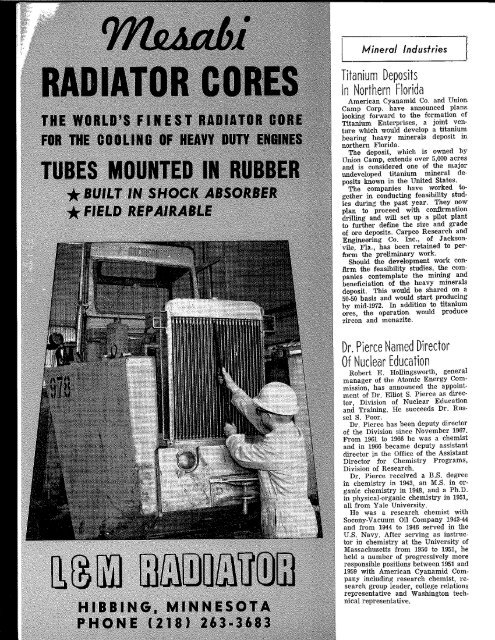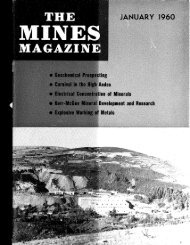The Magazine April, 1970 - Mines Magazine - Colorado School of ...
The Magazine April, 1970 - Mines Magazine - Colorado School of ...
The Magazine April, 1970 - Mines Magazine - Colorado School of ...
You also want an ePaper? Increase the reach of your titles
YUMPU automatically turns print PDFs into web optimized ePapers that Google loves.
Mineral<br />
Indusiries<br />
RADIATOR<br />
CORES<br />
THE WORLD'S FINEST RADIATOR GORE<br />
FOR THE GOO LING OF HEAVY DUTY ENGINES<br />
TUBES MOUNTED IN<br />
^ BU/LT \H SHOCK<br />
^ FIELD<br />
REPAIRABLE<br />
RUBBER<br />
ABSORBER<br />
HIBBING, MINNESOTA<br />
PHONE (218) 263-3683<br />
"itanium Deposits<br />
n Northern Florida<br />
American Cyanamid Co. and Union-<br />
Camp Corp. have announced plans<br />
lookmg forward to the formation <strong>of</strong><br />
Titanium Enterprises, a jomt venture<br />
which would develop a titanium<br />
bearmg heavy minerals deposit innorthern<br />
Florida.<br />
<strong>The</strong> deposit, which is owned by-<br />
Union Camp, extends over 5,000 acres<br />
and is considered one <strong>of</strong> the major<br />
undeveloped titanium mineral deposits<br />
known in the United States.<br />
<strong>The</strong> companies have worked together<br />
in conducting feasibility studies<br />
during the past year. <strong>The</strong>y now<br />
plan to proceed with confirmation<br />
drilling and will set up a pilot plant<br />
to further define the size and grade<br />
<strong>of</strong> ore deposits. Carpco Research and<br />
Engmeedng Co. Inc., <strong>of</strong> Jacksonvile,<br />
Fla., has been retained to perform<br />
the preliminary work.<br />
Should the development work confu-m<br />
the feasibility studies, the companies<br />
contemplate the mining and<br />
beneficiation <strong>of</strong> the heavy minerals<br />
deposit. This would be shared on a<br />
50-50 basis and would start producing<br />
by mid-1972. In addition to titanium<br />
ores, the operation would produce<br />
zircon and monazite.<br />
)r. Pierce Named Director<br />
Of Nuclear Education<br />
Robert E. HoUingsworth, general<br />
manager <strong>of</strong> the Atomic Energy Commission,<br />
has announced the appointment<br />
<strong>of</strong> Dr. Elliot S. Pierce as director,<br />
Division <strong>of</strong> Nuclear Education<br />
and Trainuig. He succeeds Dr. Russel<br />
S. Poor.<br />
Dr. Pierce has been deputy dii-ector<br />
<strong>of</strong> the Division since November 1967.<br />
From 1961 to 1966 he was a chemist<br />
and in 1966 became deputy assistant<br />
director in the Office <strong>of</strong> the Assistant<br />
Dii-ector for Chemistry Programs,<br />
Division <strong>of</strong> Research,<br />
Dr. Pierce received a B.S. degree<br />
in chemistry in 1943, an M.S. in organic<br />
chemistry in 1948, and a Ph.D.<br />
in physical-organic chemistry in 1951,<br />
all from Yale University.<br />
He was a research chemist with<br />
Socony-Vacuum Oil Company 1943-44<br />
and from 1944 to 1946 served m the<br />
U.S. Navy. After servmg as instructor<br />
in chemistry at the University <strong>of</strong><br />
Massachusetts from 1950 to 1951, he<br />
held a number <strong>of</strong> progressively more<br />
responsible positions between 1951 and<br />
1959 with American Cyanamid Company<br />
iacluding research chemist, research<br />
gi'oup leader, college relations<br />
representative and Washington technical<br />
representative.<br />
NOVEL CORRELATION OF<br />
^uptk 6 ^fYjag^netic and Cjf^cu/ilutlonci i ^dieidd<br />
VNO years ago, March 15, 1968, an<br />
article written by Dr. Raymon E.<br />
Bisgue and graduate student George<br />
E. Rouse, both from Coiorado <strong>School</strong><br />
<strong>of</strong> <strong>Mines</strong>, appeared in <strong>The</strong> <strong>Mines</strong> <strong>Magazine</strong>.<br />
This article described a novel<br />
observation concerning the earthquake<br />
zones <strong>of</strong> our planet and postulated<br />
that tbey might have some relationship<br />
to the metallic core 3000 kilometers<br />
below the surface.<br />
<strong>The</strong> following month, <strong>April</strong>, 1968,<br />
these two scientists traveled to the<br />
American Geophysical Union meeting<br />
in Washington, D. C, and presented<br />
a paper which further postulated a<br />
common cause for variation in the<br />
earth's gravitational and magnetic<br />
fields. Based on the observations previously<br />
presented, this second paper<br />
suggested that bulges or bumps on the<br />
metallic core surface were responsible<br />
for the global patterns <strong>of</strong> gravity<br />
and magnetic variations.<br />
<strong>The</strong> hypothesis, spread via the wire<br />
services and featured in Time, Newsloeek<br />
and numerous other magazines,<br />
aroused popular curiosity, a sprinkUng<br />
<strong>of</strong> scientific analysis from other quarters,<br />
and elaborate scorn from certain<br />
segments <strong>of</strong> the scientific community.<br />
Last month the British journal Nature,<br />
the counterpart <strong>of</strong> the U. S. published<br />
Science, featured an article by<br />
two scientists that have reached a<br />
very similar conclusion from independent<br />
considerations. This latter<br />
scientific communication entitled<br />
"Novel Correlation Between Global<br />
Features <strong>of</strong> the Earth's Gravitational<br />
and Magnetic Fields" was summarized<br />
in the February 19 issue <strong>of</strong> New<br />
Scientists.<br />
Within this summary, the article<br />
pointed out that several months ago<br />
at a Royal Astronomical Society meeting.<br />
Dr. Raymond Hide <strong>of</strong> the Meteorological<br />
Office, Bracknell, presented<br />
the following idea, unknown to the society.<br />
He showed the interface separating<br />
the Earth's molten core from<br />
its solid mantle might be corrugated<br />
on a vast scale. <strong>The</strong> seismologieal<br />
techniques which reveal the existence<br />
<strong>of</strong> the interface itself at a depth equivalent<br />
to just under half the earth's<br />
radius would fail to detect such<br />
"bumps" even if they were several<br />
kilometers high. Dr. Hide argued, irregularities<br />
<strong>of</strong> this magnitude would<br />
nevertheless perturb the fluid motions<br />
in the core sufficiently to explain the<br />
observed non-uniformities <strong>of</strong> the geomagnetic<br />
field which results from<br />
those motions.<br />
Following this presentation, Dr.<br />
Hide and S. R. C. MaUn <strong>of</strong> the Institute<br />
<strong>of</strong> Geological Sciences, Herstmonceux<br />
Castle, have produced supporting<br />
evidence in their pubUcation<br />
<strong>of</strong> their hypothesis which appeared<br />
in Nature, vol. 225, p. 605. Within this<br />
publication these scientists took the<br />
mathematical and statistical approach<br />
to the hypothesis, stating there is a<br />
significant correlation between the<br />
Earth's gravitational field and the<br />
non-dipole part <strong>of</strong> the geomagnetic<br />
field, provided the latter is displaced<br />
in longitude.<br />
An interrelated correlation to the<br />
hypothesis developed at the <strong>Colorado</strong><br />
<strong>School</strong> <strong>of</strong> <strong>Mines</strong> two years ago also<br />
showed the correlation <strong>of</strong> active<br />
crustal zones <strong>of</strong> the earth with planes<br />
tangent to the outer core. This hypothesis<br />
was supported on the theory<br />
that tbe surface pattern was a result<br />
<strong>of</strong> a global stress system that originates<br />
at the core-mantle interface and<br />
results from differential movements<br />
<strong>of</strong> core and mantle material.<br />
YOUR<br />
XPIORATION PROGRAM<br />
/// Be M o r e Effecfive If You<br />
INTEGRATE geochemical exploration methods with geologic and geophysical<br />
techniques;<br />
APPLY the results <strong>of</strong> geochemical orientation studies conducted by experienced<br />
field geochemists and trace analysts In planning your<br />
program;<br />
UTILIZE trained, properly supervised field crews for geochemicai mapping;<br />
SELECT competent exploration-oriented chemists to perform your trace<br />
analyses;<br />
INSURE the receipt <strong>of</strong> your geochemical data in time to follow up areas<br />
<strong>of</strong> interest during your field season,<br />
CALL OR WRITE:<br />
SKYLINE LABS. INC.<br />
Specialists in Geochemical Exploration<br />
Edwin V. Post, Presidenf, Geologist<br />
Charles E. Thompson, Vice President, Chief Chemist<br />
E. J. Mayhew, '41, Vice-President, Geological Engineer<br />
Roberf McMillan, '41, Secretary-Treasurer, Geological Engineer<br />
William L. Lehmbeck, '62, Staff Geologist<br />
12090 W. SOth PI. Wheat Ridge (Denver), Colo. 80033<br />
Tel. (303) 424-7718<br />
THE MINES MAGAZINE • APRIL, <strong>1970</strong> 19

















